Taj Mahal Travellers
- Between 6:20 - 6:46 PM (Live)
- July 15, 1972 · 1972
- Taj Mahal Travellers 1 (1)
- August 1974 · 1974
- August 1974 - I (Remastered)
- July 15, 1972 & August 1974 (Remastered) · 1975
- Taj Mahal Travellers 1 (3)
- August 1974 - III (Remastered)
- Between 7:03 - 7:15 PM (Live)
- Between 7:50 - 8:05 PM (Live)
- Taj Mahal Travellers 1 (2)
- August 1974 - II (Remastered)
- August 1974 - IV (Remastered)

Live Albums
About taj mahal travellers.
The Taj Mahal Travellers were a legendary improvisational group out of Tokyo, who combined Eastern and Western instruments, electronics and vocal chants, and used heavy post-production processing to create unique long flowing jams, with deep organic droning and pulsing, similar to some of the cosmic electronic stuff out of Germany at the same time, though filtered through a Japanese sensibility. Their music is considered at the pinnacle of Asian psychedelic music of the late 1960s and early 1970s. At the same time they were far closer to avant-garde minimalism, with some of the group even disavowing the psychedelic connection. Their few recordings feature long untitled freeform tracks, often taking up an entire side of the record. Formed in 1969 by Takehise Kosugi, a violinist who had already been associated with the Fluxus movement, along with Ryo Koike, Michihiro Kimura, Yukio Tsuchiya, Seiji Nagai, Tokio Hadegawa, and Kinji Hayashi, the Taj Mahal Travellers soon began to perform inter-media concerts in Japan. Between 1971 and 1972 they toured much of Europe and Asia, mostly traveling around in a Volkswagen mini-bus, and even performing at the Taj Mahal in India. For a concert at the Moderna Museet (Modern Museum) in Stockholm, released thirty years later on the double CD Live Stockholm July 1971 by Drone Syndicate, the group was down to the trio of Koike, Kimura, and Tsuchiya. Soon after the tour abroad live material was recorded at the Sohgetsu Hall in Tokyo and released as the LP July 15, 1972 on the Sony label. In 1973 another live performance was featured on one side of the double LP compilation Oz Days Live (also known as Live at Oz), from the underground Oz label. The next year the group went into the studio to record more material, and this was released as the double LP August 1974 on Sony in 1975. The group disbanded that year, and Kosugi continued a prolific solo career, as well as to help some of his music students to start the Taj Mahal Travellers-like group East Bionic Symphonia, who released a self-titled album in 1976. Seiji Nagai went on to study Indian music and electronic music, and finally released a CD Electronic Noise Improvisation 1999, which attempts to recreate the Taj Mahal Travellers spirit with the use of dense electronic drones. ~ Rolf Semprebon
Similar Artists
Far east family band, les rallizes dénudés, karuna khyal, acid mothers temple, kris wanders, takehis kosugi, uchihashi kazuhisa, derek and the ruins, select a country or region, africa, middle east, and india.
- Côte d’Ivoire
- Congo, The Democratic Republic Of The
- Guinea-Bissau
- Niger (English)
- Congo, Republic of
- Saudi Arabia
- Sierra Leone
- South Africa
- Tanzania, United Republic Of
- Turkmenistan
- United Arab Emirates
Asia Pacific
- Indonesia (English)
- Lao People's Democratic Republic
- Malaysia (English)
- Micronesia, Federated States of
- New Zealand
- Papua New Guinea
- Philippines
- Solomon Islands
- Bosnia and Herzegovina
- France (Français)
- Deutschland
- Luxembourg (English)
- Moldova, Republic Of
- North Macedonia
- Portugal (Português)
- Türkiye (English)
- United Kingdom
Latin America and the Caribbean
- Antigua and Barbuda
- Argentina (Español)
- Bolivia (Español)
- Virgin Islands, British
- Cayman Islands
- Chile (Español)
- Colombia (Español)
- Costa Rica (Español)
- República Dominicana
- Ecuador (Español)
- El Salvador (Español)
- Guatemala (Español)
- Honduras (Español)
- Nicaragua (Español)
- Paraguay (Español)
- St. Kitts and Nevis
- Saint Lucia
- St. Vincent and The Grenadines
- Trinidad and Tobago
- Turks and Caicos
- Uruguay (English)
- Venezuela (Español)
The United States and Canada
- Canada (English)
- Canada (Français)
- United States
- Estados Unidos (Español México)
- الولايات المتحدة
- États-Unis (Français France)
- Estados Unidos (Português Brasil)
- 美國 (繁體中文台灣)
If you're seeing this message, it means we're having trouble loading external resources on our website.
If you're behind a web filter, please make sure that the domains *.kastatic.org and *.kasandbox.org are unblocked.
To log in and use all the features of Khan Academy, please enable JavaScript in your browser.
AP®︎/College Art History
Course: ap®︎/college art history > unit 10.
- Beliefs of Hinduism
- Beliefs made visible: Hindu art in South Asia
- Hindu temples
- Sacred space and symbolic form at Lakshmana Temple, Khajuraho (India)
- The Historical Buddha
- Introduction to Buddhism
- Beliefs made visible: Buddhist art in South Asia
- The Great Stupa at Sanchi
- Shiva as Lord of the Dance (Nataraja)
- Bichitr, Jahangir Preferring a Sufi Shaikh to Kings
The Taj Mahal
The location, paradise on earth, the gardens, what the taj mahal represents.
"The physical fabric is in good condition and structural stability, nature of foundation, verticality of the minarets and other constructional aspects of Taj Mahal have been studied and continue to be monitored."
Want to join the conversation?
- Upvote Button navigates to signup page
- Downvote Button navigates to signup page
- Flag Button navigates to signup page

Visiting the Taj Mahal: Everything you need to know
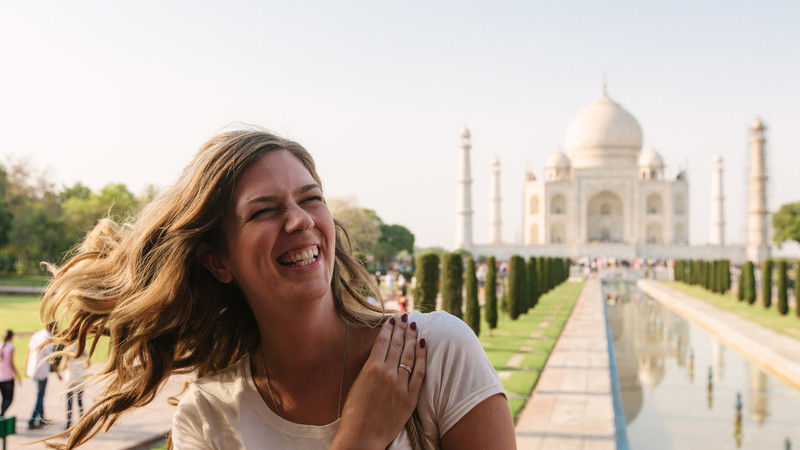
Is there a sight more iconic, more beautiful, more jaw-droppingly spectacular than the Taj Mahal?
Quite honestly, we can’t think of one.
At the very least, there’s no mausoleum more grand, no declaration of love more apparent than building a marble masterpiece for one’s favorite wife… And no better reason to travel than seeing its magnificence up close.
After all, this is art. Built in Agra, India between 1631 and 1648, it’s also history. And, of course, it’s the perfect opportunity to take some otherworldly photos. So, to help visitors prepare for their Taj Mahal travels, we’ve prepared a little guide, enlisting the help of some Intrepid experts – from Destination Managers to acclaimed trip leaders – to cover all the bases.
Coming up: what to bring, where to take the best snaps, what else to see in Agra (and beyond), and so much more…
Before you arrive at the Taj Mahal
That old saying ‘patience is a virtue’ really comes into its own when discussing the Taj Mahal.
Be prepared to be surrounded by hundreds (if not thousands) of people. These include Indian men, women and children who may ask to take photos with you.
To prepare with the help of other travelers and a local tour guide, consider taking a group tour. Intrepid have Taj-visiting trips that range from 8-day Golden Triangle tours (now with solo-only departures !) to 15-day trips dedicated to food , to 19-day trips combining the highlights of India and Nepal .
If you’re more pressed for time, you can check out the Taj Mahal on a whirlwind day tour from Delhi. Check out Urban Adventures to see the itinerary that we’d recommend for this. And while you’re at it, check out their day trips in Delhi , Jaipur , Varanasi and Mumbai !
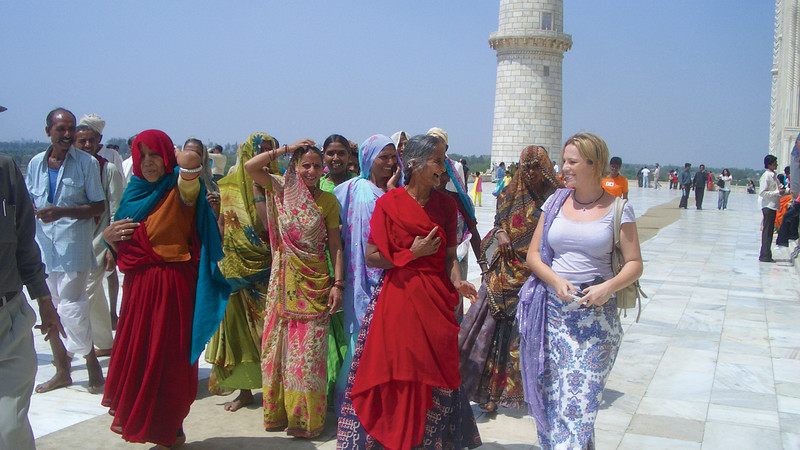
What to bring to the Taj Mahal
Always leave your valuables in the hotel. There are lockers available at the Taj but it’s best to have minimal belongings on you so you don’t spend too much time checking in.
You really only need to bring the following in one small bag:
What to wear to the Taj Mahal
There is no dress code but you should still be respectful. If you want to enter the mosque, you will need to cover your head, shoulders and knees.
It gets hot in Agra and there is very little shade, so wear light clothing and make sure you wear sunscreen. Then again, Agra also gets very cold in winter (Nov-Feb) so layers are your friend too.
If you visit with Intrepid, you’ll be taken there earlier in the day or later in the afternoon to avoid the worst of the heat.
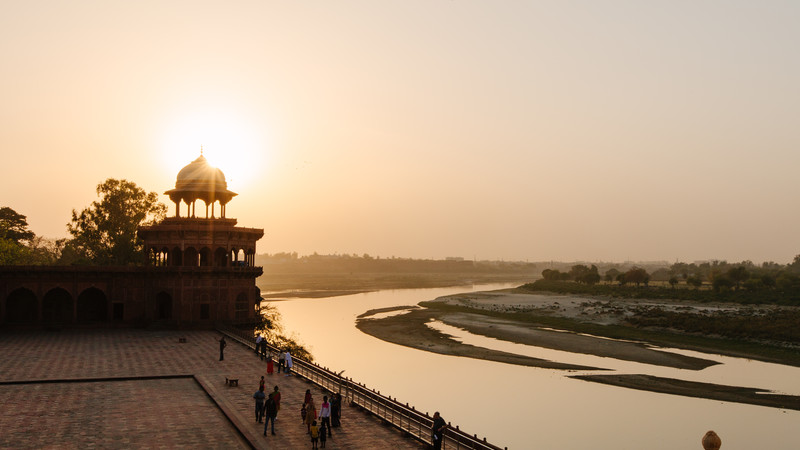
Having been to the Taj a few times, I’ve learnt the importance of wearing shoes that are easy to remove. You need to take your shoes off when you go inside and the easier they are to slip on and off the better. This actually applies to much of India – shoes with loads of laces are hard!
Other things you need to know
No food is allowed inside.
Cigarettes and lighters are also not allowed.
Tripods and additional lighting equipment need prior permission to be brought with. Photography inside the mausoleum is prohibited. Most electronics (except cameras and small video cameras) are not allowed.
Be wary of touts, thieves and rude shop keepers. It’s a busy, high-pressure area, but keep your wits about you and you won’t need to worry!
When you’re at the Taj Mahal
Go early, wait for space to explore and photograph, and get yourself away from the crowds (if possible).
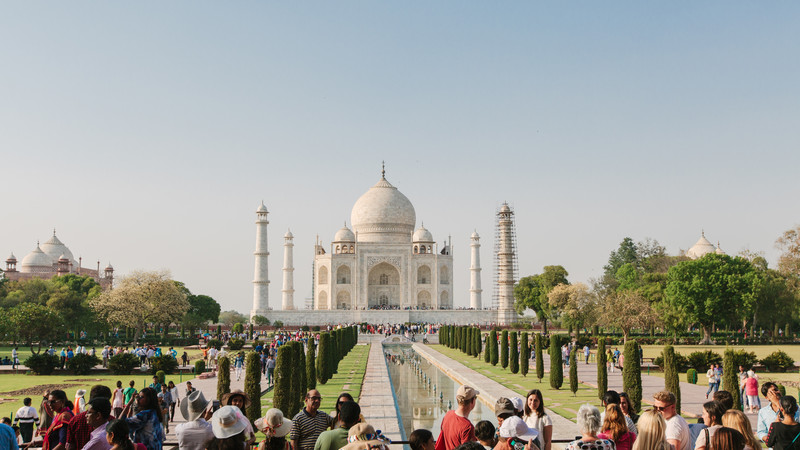
And simply focus on taking in all the magic. Even Intrepid leaders who see the Taj Mahal monthly (or more!) remain in awe of it. Sana Jinah , one of the company’s inspiring female tour guides, has some tips on how to do this:
The Taj Mahal is a place for exploring quietly on your own or with loved ones. So, once I’m done briefing my groups I give them a good 2-3 hours inside the Taj. There are ways I try to make the experience special and memorable for travelers, but if I say what they are then they will no longer be surprises! The Taj has such a charm. Every time I see it it looks different (due to the direction of the sunlight). It’s so beautiful…
She also recommends those looking for optimum conditions try visiting the Taj Mahal at sunrise on a clear day.
Tips for taking photos at the Taj Mahal
Everyone wants that iconic shot of themselves at the Taj Mahal. You know the one – where you sit on the bench and the grandeur of the marble mausoleum forms the backdrop.
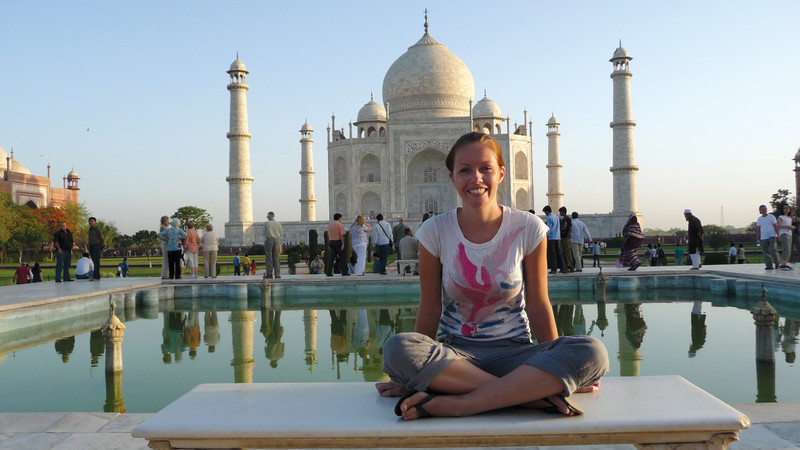
Below are some photography suggestions from Intrepid’s General Manager in India, Pravin Tamang . (His photography is amazing – check it out !)
- Shot from the arch of the main doorway
- Capture the reflection of the fountains that line the route towards the Taj Mahal’s main platform
- Shot of Taj Mahal from the riverside with the reflection on the river
- Shot from the other side of the river, ‘Mehtab Bagh’, where you get a glimpse of Taj
- The Taj Mahal can also be shot from some parts of the Red Fort
You can also get great photos from the many rooftops of restaurants close to the Taj Mahal. Unfortunately, Agra does get pretty smoggy, so winter can often have poor visibility earlier in the day and around sunset. That said, this can make shots look very atmospheric!
What to do after visiting the Taj Mahal
First, go back to your hotel room, take a shower, and revel in the relative peace and quiet. Then explore these cool destinations both in and out of Agra:
What to do in Agra
The Taj Mahal is, quite clearly, the star of the show in this northern Indian city. But the Agra Fort is also stunning, especially if you didn’t get a chance to go to the Red Fort in Delhi. A 16th-century Mughal monument and UNESCO World Heritage site, it’s a sight not to be missed.
Despite being located on the Golden Triangle tourist circuit, there’s less to do in Agra than in many other Indian cities. It’s pretty polluted from the heavy industry (more on that later) and you likely won’t spend too long there, whatever the trip.
One way that Intrepid tries to show visitors a different perspective on the country is by (sometimes) taking travelers to Sheroes Hangout . Just blocks from the Taj Mahal, it’s a small cafe run entirely by female acid attack survivors. Here, victims of attacks are employed and tell their stories. It can be confronting, but also inspiring and memorable in equal measures.
SUBSCRIBE TO INTREPID’S NEWSLETTER FOR MORE TRAVEL GUIDES, COMPETITIONS, GIVEAWAYS & MORE
Where to go outside of Agra
There are various great destinations only a few hours drive (well, 4-7) from the Taj Mahal. Of these, Orchha, Jaipur and Pushkar are all tourist-friendly, peaceful and beautiful places.
Orchha is a town that travelers often overlook. This is a shame, because it’s historic, laid-back and has a bunch of beautiful temples. It’s not always on tour itineraries, but you CAN visit it on this 15-day trip from Delhi to Kathmandu (cooking demo and palace visit included!).
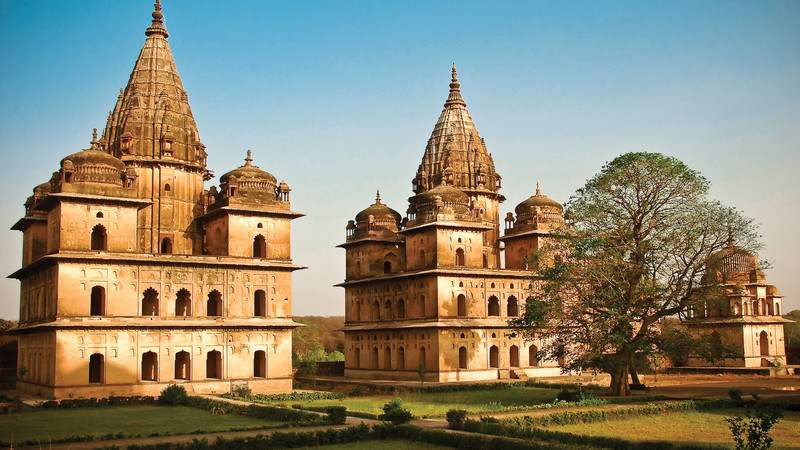
Chaturbhuj Temple in Orchha
Jaipur is much more well-known. Also known as the ‘Pink City’ , the capital of Rajasthan is full of chaos, charm and unique architecture. Visit the hilltop Amber Fort, haggle in the enchanting bazaars, and consider taking a hot air balloon over the city to take it all in.
Pushkar is another underrated town. One of the oldest and most serene towns in India, it’s home to Pushkar Lake, a sacred spot for Hindus that’s utterly dazzling at sundown. Because of its holy nature, the vegetarian food here is simply unmissable. Visit on this 15-day trip all around Rajasthan.

A final note about the Taj Mahal’s mud therapy
As you may have read or heard, the Taj Mahal has recently been undergoing a very thorough clean. Yep, to be precise, a mud mask as of April 2018.
Why? Air pollution from factories in Agra had been slowly turning the Taj Mahal’s ivory-white surfaces yellow – and this was one way of restoring them to their former glory. The work – applying a clay traditionally used to clean marble to the entire structure of the Taj – was carried out by the Archaeological Survey of India. And this work was part of a series of restorative projects carried out on the historic site.
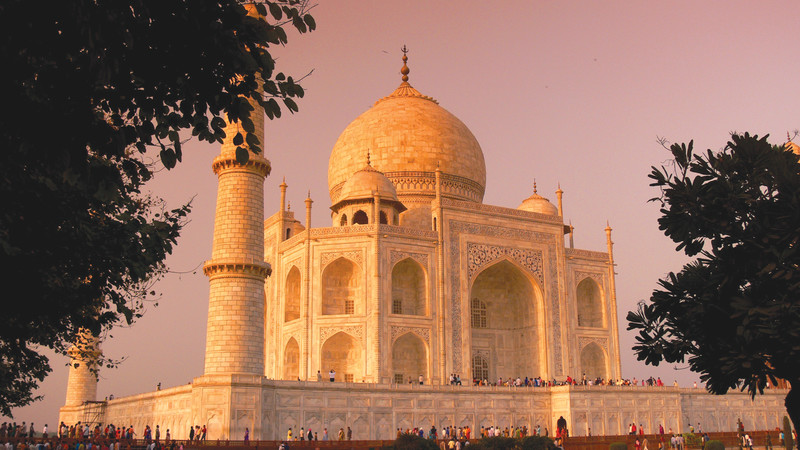
(Image credits from top to bottom: Intrepid Travel, Stephanie Young, Intrepid Travel, Intrepid Travel, Sarah Dibdin, Chris Grundy, Hamish Cattell, David Williams)
Feeling inspired?
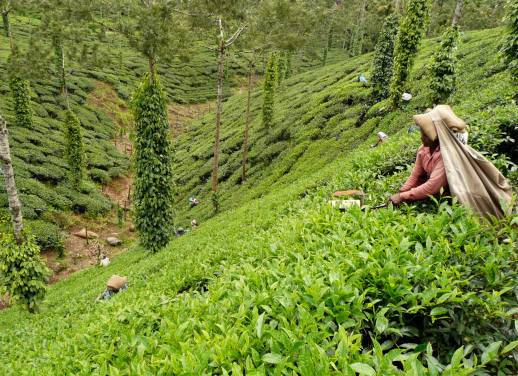
Bex Shapiro
Born in London and based in Toronto, Bex is happiest anywhere she can connect with interesting people over good food. She's passionate about sustainable travel and powerful storytelling, and her favourite cities are New York and Shanghai. She's also the Senior Editorial Manager at Intrepid. Follow her adventures on Twitter and Insta @BexShapiro.
You might also like
The 7 best places to go on a..., 5 reasons to visit sri lanka in the..., why 2024 is the best year to see..., yellowstone vs yosemite: which national park to visit, 6 unique experiences you can have in el..., from delhi to udaipur, here are the five..., cinque terre vs amalfi coast: which destination to..., love at first bite: 10 famous sandwiches from..., galapagos or madagascar which unique destination should be..., central vs south america: how to plan your..., 4 reasons you should take a road trip....
Taj Mahal Travellers
Take advantage of the search to browse through the World Heritage Centre information.
Share on social media
Unesco social media.
- Description
An immense mausoleum of white marble, built in Agra between 1631 and 1648 by order of the Mughal emperor Shah Jahan in memory of his favourite wife, the Taj Mahal is the jewel of Muslim art in India and one of the universally admired masterpieces of the world's heritage.
Description is available under license CC-BY-SA IGO 3.0
Le Taj Mahal
Immense mausolée funéraire de marbre blanc édifiée entre 1631 et 1648 à Agra sur l'ordre de l'empereur moghol Shah Jahan pour perpétuer le souvenir de son épouse favorite, le Taj Mahal, joyau le plus parfait de l'art musulman en Inde, est l'un des chefs-d'œuvre universellement admirés du patrimoine de l'humanité.
إنّ تاج محل هو ضريح جنائزي هائل شُيّد من الرخام الأبيض بين عامي 1631 و1648 في أغرا بناءً على أوامر الإمبراطور المغولي شاه جهان بهدف تخليد ذكرى زوجته المفضّلة. ويشكّل تاج محل الذي يُعتبر أفضل جوهرة في الفن الإسلامي في الهند إحدى أبرز تُحف التراث البشري التي هي محطّ إعجاب العالم بأسره.
source: UNESCO/CPE Description is available under license CC-BY-SA IGO 3.0
泰姬陵是一座由白色大理石建成的巨大陵墓清真寺,是莫卧儿皇帝沙贾汗(Shah Jahan)为纪念他心爱的妃子于1631年至1648年在阿格拉修建的。泰姬陵是印度穆斯林艺术的瑰宝奇葩,是世界遗产中令世人赞叹的经典杰作之一。
Outstanding Universal Value
Brief synthesis
The Taj Mahal is located on the right bank of the Yamuna River in a vast Mughal garden that encompasses nearly 17 hectares, in the Agra District in Uttar Pradesh. It was built by Mughal Emperor Shah Jahan in memory of his wife Mumtaz Mahal with construction starting in 1632 AD and completed in 1648 AD, with the mosque, the guest house and the main gateway on the south, the outer courtyard and its cloisters were added subsequently and completed in 1653 AD. The existence of several historical and Quaranic inscriptions in Arabic script have facilitated setting the chronology of Taj Mahal. For its construction, masons, stone-cutters, inlayers, carvers, painters, calligraphers, dome builders and other artisans were requisitioned from the whole of the empire and also from the Central Asia and Iran. Ustad-Ahmad Lahori was the main architect of the Taj Mahal.
The Taj Mahal is considered to be the greatest architectural achievement in the whole range of Indo-Islamic architecture. Its recognised architectonic beauty has a rhythmic combination of solids and voids, concave and convex and light shadow; such as arches and domes further increases the aesthetic aspect. The colour combination of lush green scape reddish pathway and blue sky over it show cases the monument in ever changing tints and moods. The relief work in marble and inlay with precious and semi precious stones make it a monument apart.
The uniqueness of Taj Mahal lies in some truly remarkable innovations carried out by the horticulture planners and architects of Shah Jahan. One such genius planning is the placing of tomb at one end of the quadripartite garden rather than in the exact centre, which added rich depth and perspective to the distant view of the monument. It is also, one of the best examples of raised tomb variety. The tomb is further raised on a square platform with the four sides of the octagonal base of the minarets extended beyond the square at the corners. The top of the platform is reached through a lateral flight of steps provided in the centre of the southern side. The ground plan of the Taj Mahal is in perfect balance of composition, the octagonal tomb chamber in the centre, encompassed by the portal halls and the four corner rooms. The plan is repeated on the upper floor. The exterior of the tomb is square in plan, with chamfered corners. The large double storied domed chamber, which houses the cenotaphs of Mumtaz Mahal and Shah Jahan, is a perfect octagon in plan. The exquisite octagonal marble lattice screen encircling both cenotaphs is a piece of superb workmanship. It is highly polished and richly decorated with inlay work. The borders of the frames are inlaid with precious stones representing flowers executed with wonderful perfection. The hues and the shades of the stones used to make the leaves and the flowers appear almost real. The cenotaph of Mumtaz Mahal is in perfect centre of the tomb chamber, placed on a rectangular platform decorated with inlaid flower plant motifs. The cenotaph of Shah Jahan is greater than Mumtaz Mahal and installed more than thirty years later by the side of the latter on its west. The upper cenotaphs are only illusory and the real graves are in the lower tomb chamber (crypt), a practice adopted in the imperial Mughal tombs.
The four free-standing minarets at the corners of the platform added a hitherto unknown dimension to the Mughal architecture. The four minarets provide not only a kind of spatial reference to the monument but also give a three dimensional effect to the edifice.
The most impressive in the Taj Mahal complex next to the tomb, is the main gate which stands majestically in the centre of the southern wall of the forecourt. The gate is flanked on the north front by double arcade galleries. The garden in front of the galleries is subdivided into four quarters by two main walk-ways and each quarters in turn subdivided by the narrower cross-axial walkways, on the Timurid-Persian scheme of the walled in garden. The enclosure walls on the east and west have a pavilion at the centre.
The Taj Mahal is a perfect symmetrical planned building, with an emphasis of bilateral symmetry along a central axis on which the main features are placed. The building material used is brick-in-lime mortar veneered with red sandstone and marble and inlay work of precious/semi precious stones. The mosque and the guest house in the Taj Mahal complex are built of red sandstone in contrast to the marble tomb in the centre. Both the buildings have a large platform over the terrace at their front. Both the mosque and the guest house are the identical structures. They have an oblong massive prayer hall consist of three vaulted bays arranged in a row with central dominant portal. The frame of the portal arches and the spandrels are veneered in white marble. The spandrels are filled with flowery arabesques of stone intarsia and the arches bordered with rope molding.
Criterion (i): Taj Mahal represents the finest architectural and artistic achievement through perfect harmony and excellent craftsmanship in a whole range of Indo-Islamic sepulchral architecture. It is a masterpiece of architectural style in conception, treatment and execution and has unique aesthetic qualities in balance, symmetry and harmonious blending of various elements.
Integrity is maintained in the intactness of tomb, mosque, guest house, main gate and the whole Taj Mahal complex. The physical fabric is in good condition and structural stability, nature of foundation, verticality of the minarets and other constructional aspects of Taj Mahal have been studied and continue to be monitored. To control the impact of deterioration due for atmospheric pollutants, an air control monitoring station is installed to constantly monitor air quality and control decay factors as they arise. To ensure the protection of the setting, the adequate management and enforcement of regulations in the extended buffer zone is needed. In addition, future development for tourist facilities will need to ensure that the functional and visual integrity of the property is maintained, particularly in the relationship with the Agra Fort.
Authenticity
The tomb, mosque, guest house, main gate and the overall Taj Mahal complex have maintained the conditions of authenticity at the time of inscription. Although an important amount of repairs and conservation works have been carried out right from the British period in India these have not compromised to the original qualities of the buildings. Future conservation work will need to follow guidelines that ensure that qualities such as form and design continue to be preserved.
Protection and management requirements
The management of Taj Mahal complex is carried out by the Archaeological Survey of India and the legal protection of the monument and the control over the regulated area around the monument is through the various legislative and regulatory frameworks that have been established, including the Ancient Monument and Archaeological Sites and Remains Act 1958 and Rules 1959 Ancient Monuments and Archaeological Sites and Remains (Amendment and Validation); which is adequate to the overall administration of the property and buffer areas. Additional supplementary laws ensure the protection of the property in terms of development in the surroundings.
An area of 10,400 sq km around the Taj Mahal is defined to protect the monument from pollution. The Supreme Court of India in December, 1996, delivered a ruling banning use of coal/coke in industries located in the Taj Trapezium Zone (TTZ) and switching over to natural gas or relocating them outside the TTZ. The TTZ comprises of 40 protected monuments including three World Heritage Sites - Taj Mahal, Agra Fort and Fatehpur Sikri.
The fund provided by the federal government is adequate for the buffer areas. The fund provided by the federal government is adequate for the overall conservation, preservation and maintenance of the complex to supervise activities at the site under the guidance of the Superintending Archaeologist of the Agra Circle. The implementation of an Integrated Management plan is necessary to ensure that the property maintains the existing conditions, particularly in the light of significant pressures derived from visitation that will need to be adequately managed. The Management plan should also prescribe adequate guidelines for proposed infrastructure development and establish a comprehensive Public Use plan.
- Moghal Gardens (World Heritage Review)
- World Heritage in India (Archaeological Survey of India)
State of Conservation (SOC)
Taj Mahal By Salman Rushdie
The trouble with the Taj Mahal is that it has become so overlaid with accumulated meanings as to be almost impossible to see. A billion chocolate-box images and tourist guidebooks order us to "read" the Mughal emperor Shah Jahan's marble mausoleum for his wife Mumtaz Mahal, known as "Taj Bibi," as the World's Greatest Monument to Love. It sits at the top of the West's short list of images of the Exotic (and also Timeless) Orient. Like the Mona Lisa, like Andy Warhol's silk-screened Elvis, Marilyn, and Mao, mass reproduction has all but sterilized the Taj Mahal.
Nor is this by any means a simple case of the West's appropriation or "colonization" of an Indian masterwork. In the first place, the Taj, which in the mid-19th century had been all but abandoned and had fallen into a severe state of disrepair, would probably not be standing today were it not for the diligent conservationist efforts of the colonial British. In the second place, India is perfectly capable of over merchandising itself.
When you arrive at the outer walls of the gardens in which the Taj is set, it's as if every hustler and hawker in Agra is waiting for you to make the familiarity-breeds-contempt problem worse, peddling imitation Tajs of every size and price.
All this breeds a certain amount of shoulder-shrugging disenchantment. Recently, a British friend who was about to make his first trip to India told me that he had decided to leave the Taj off his itinerary because of its overexposure. If I urged him not to, it was because of my own vivid memory of pushing my way for the first time through the jostling crowd, not only of imitation-vendors but also of prescribed readings, past all the myriad hawkers of meaning and interpretation, and into the presence of the thing-in-itself; which utterly overwhelmed me, and made all my notions about its devaluation feel totally and completely redundant.
I had been skeptical about the visit. One of the legends of the Taj is that the hands of the master masons who built it were cut off by the emperor, so that they could never build anything lovelier. Another is that the mausoleum was constructed in secrecy behind high walls, and a man who tried to sneak a preview was blinded for his interest in architecture. My personal imagined Taj was somewhat tarnished by these cruel tales.
The building itself left my skepticism in shreds, however. Announcing itself as itself, insisting with absolute force on its sovereign authority, it simply obliterated the million counterfeits of it and glowingly filled, once and forever, the place in the mind previously occupied by its simulacra.
And this, finally, is why the Taj Mahal must be seen: to remind us that the world is real, that the sound is truer than the echo, the original more forceful than its image in a mirror. The beauty of beautiful things is still able, in these image-saturated times, to transcend imitations. And the Taj Mahal is, beyond the power of words to say it, a lovely thing, perhaps the loveliest of things.
The information in this story was accurate at the time it was published, but we suggest you confirm all details before making travel plans.

August 1974
Taj mahal travellers.
STREAM OR BUY:
Release Date
Recording date, recording location, discography timeline, allmusic review, user reviews, track listing, similar albums.
DoubleTree by Hilton Hotel Agra
Rating: 4.5 out of 5.0
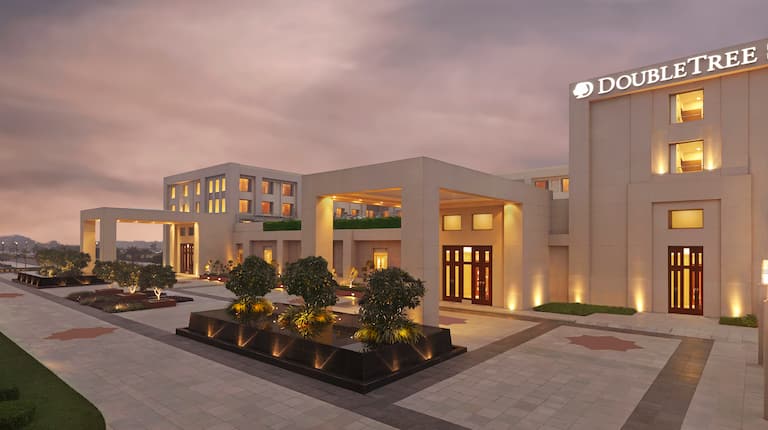
Arrival Time
Infinity pool minutes from the Taj Mahal
Find us 10 minutes from the Taj Mahal. Agra Fort, Itmad-ud-Daula, and Pandit Deen Dayal Upadhyaya Airport are all within 11 kilometers. We offer an infinity pool, a 24-hour fitness center, and a concierge. Enjoy a treatment in our spa, all-day dining in our restaurants, and a DoubleTree Chocolate Chip Cookie when you arrive.
Our amenities
Connecting Rooms
Free parking
On-site restaurant
Outdoor pool
Fitness center
Room service
Business center
Meeting rooms
Pets not allowed
Rooms and suites
Hilton Honors member benefits
Hilton Honors Discount rate
Points toward free nights and more
Choose Your Room
Digital Check-In
Hilton Honors Experiences
Digital Key
Hotel policies
Not available
Possession and consumption of Hookah are prohibited on hotel premises.
Standard in-room and lobby WiFi: ₹480.00
Dining and drinks
North 27 serves global cuisine buffet and à la carte style, with live cooking stations and courtyard views. Kebab-e-que offers fine Indian dishes for dinner in an elegant setting. The Plush Bar is open 24 hours.
Group travel and events
Location and transportation.
Airport shuttle

IMAGES
COMMENTS
The Taj Mahal Travellers (also given variously as Taj Mahal Travelers, Taj-Mahal Travellers, etc.) were a Japanese experimental music ensemble founded in 1969 by former Group Ongaku leader and Fluxus member Takehisa Kosugi. The rest of the group were several years younger than Kosugi, and were all inspired by the spirit of the day.
Early experimental drone/ambient Japanese musicA The Taj-Mahal Travelers Between 6:20~6:46P.M. 0:00 B1 The Taj-Mahal Travelers Between 7:03~7:15P.M. 25:39 ...
Active. 1970s. Genre. Pop/Rock, Jazz. Styles. Experimental, Free Improvisation, Alternative/Indie Rock, Experimental Rock. Submit Corrections. Explore Taj Mahal Travellers's discography including top tracks, albums, and reviews. Learn all about Taj Mahal Travellers on AllMusic.
The Taj Mahal Travellers were a Japanese experimental music ensemble founded in 1969 by former Group Ongaku leader and Fluxus member Takehisa Kosugi. The rest of the group were several years younger than Kosugi, and were all inspired by the spirit of the day. They chose mainly to perform their music outdoors, often on beaches and hilltops, creating spontaneously improvised drones, often using ...
Tracklist:1. Live '71, Pt.1 00:002. Live '71, Pt.2 58:36Release title on spines: live Stockholm 1971Band credits:On front insert: Taj•Mahal TravellersOn rear...
The Taj-Mahal Travellers. Formed in 1969 by "six meta-music creators & one electronic engineer", this group created stunning cosmic music which was always entirely improvised. The ensemble regularly played throughout Japan and was best known for events such as playing all day at a beach in Kanagawa. In 1971, they made their first tour of Europe ...
Taj-Mahal Travellers biography Founded in Tokyo, Japan in 1969 - Disbanded in 1975 Formed by the contemporary "fluxus" artist Takehisa KOSUGI, the musical project Taj-Mahal Travellers started various musical improvisations at the end of the 60s.Their two studio albums, respectively published in 1972 and 1974 present a vast collection of sonic interferences, electro-drones and massive spacey ...
The Taj Mahal Travellers were a legendary improvisational group out of Tokyo, who combined Eastern and Western instruments, electronics and vocal chants, and used heavy post-production processing to create unique long flowing jams, with deep organic droning and pulsing, similar to some of the cosmic electronic stuff out of Germany at the same time, though filtered through a Japanese sensibility.
Takehisa Kosugi was a hippie become avantgarde composer. Born in Tokyo in 1938, and graduated in 1962 at the Tokyo University of Arts, Kosugi founded the Jap...
Taj Mahal, Agra, India, 1632-53 (photo: King of Hearts, CC BY-SA 4.0) Shah Jahan was the fifth ruler of the. Mughal dynasty. During his third regnal year, his favorite wife, known as Mumtaz Mahal, died due to complications arising from the birth of their fourteenth child. Deeply saddened, the emperor started planning the construction of a ...
Taj Mahal, Agra, India, designated a World Heritage site in 1983. Taj Mahal, mausoleum complex in Agra, western Uttar Pradesh state, northern India. The Taj Mahal was built by the Mughal emperor Shah Jahān (reigned 1628-58) to immortalize his wife Mumtaz Mahal ("Chosen One of the Palace"), who died in childbirth in 1631, having been the ...
Taj Mahal Travellers' "July 15, 1972" offers a compelling dive into the avant-garde, capturing the essence of experimental music with a raw and unyielding spirit. This album, comprised of three sprawling pieces, orchestrates a sound that defies the conventional boundaries of musical structure and form. The opening track, a 25-minute epic ...
Intrepid have Taj-visiting trips that range from 8-day Golden Triangle tours (now with solo-only departures !) to 15-day trips dedicated to food, to 19-day trips combining the highlights of India and Nepal. If you're more pressed for time, you can check out the Taj Mahal on a whirlwind day tour from Delhi.
February 21, 2018. • 5 min read. The Taj Mahal is widely considered one of the most beautiful buildings ever created. The exquisite marble structure in Agra, India, is a mausoleum, an enduring ...
In 1969 he formed the Taj Mahal Travellers, a psychedelic-rock group that played lengthy improvised jams that can be summarized in three principles: a Far-Eastern approach to music as a living organism, an intense electronic processing of instruments and voices, a semi-mathematical overlapping of frequencies. Basically: LaMonte Young on acid.
Taj Mahal. An immense mausoleum of white marble, built in Agra between 1631 and 1648 by order of the Mughal emperor Shah Jahan in memory of his favourite wife, the Taj Mahal is the jewel of Muslim art in India and one of the universally admired masterpieces of the world's heritage. Description is available under license CC-BY-SA IGO 3.0.
The Taj Mahal was built in 1651 as a mausoleum for the wife of the Shah Jahan. The trouble with the Taj Mahal is that it has become so overlaid with accumulated meanings as to be almost impossible ...
A documentary about the trip that brought these japanese avant-garde musicians from Amsterdam to the Taj Mahal in India. It's a sort of surrealist road movie...
Taj Mahal Travellers discography and songs: Music profile for Taj Mahal Travellers, formed 1969. Genres: Free Improvisation, Drone, Electroacoustic. Albums include July 15, 1972, August 1974, and Live Stockholm July, 1971.
Ticket prices. The cost of entry to the Taj Mahal increased in 2018. Foreigners must pay 1,100 rupees (around £12), with a 50-rupee discount if they pay by card. Indians only pay 50 rupees ...
Released. 1973 — UK. Vinyl —. LP, Album, Stereo. Explore the tracklist, credits, statistics, and more for 1 - August 1974 by Taj Mahal Travellers. Compare versions and buy on Discogs.
August 1974 by Taj Mahal Travellers released in 1974. Find album reviews, track lists, credits, awards and more at AllMusic.
Free Improvisation, Drone. Length. 49:56. Label. CBS Japan SOCM-95. Producer. Go Hamada [1] July 15, 1972 is the second album by Taj Mahal Travellers. It was recorded live at the Sogetsu Hall in Tokyo, Japan on July 15, 1972.
Find us 10 minutes from the Taj Mahal. Agra Fort, Itmad-ud-Daula, and Pandit Deen Dayal Upadhyaya Airport are all within 11 kilometers. We offer an infinity pool, a 24-hour fitness center, and a concierge. Enjoy a treatment in our spa, all-day dining in our restaurants, and a DoubleTree Chocolate Chip Cookie when you arrive.